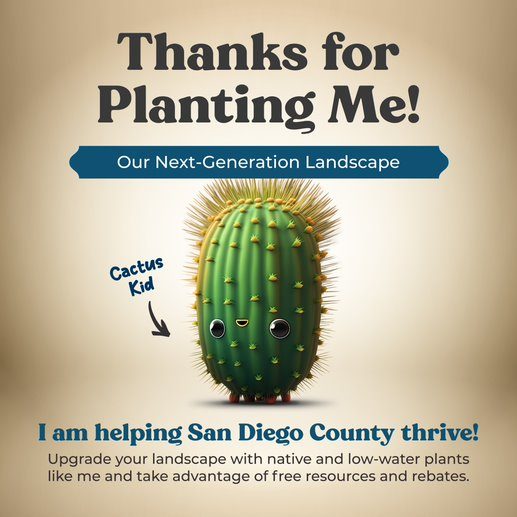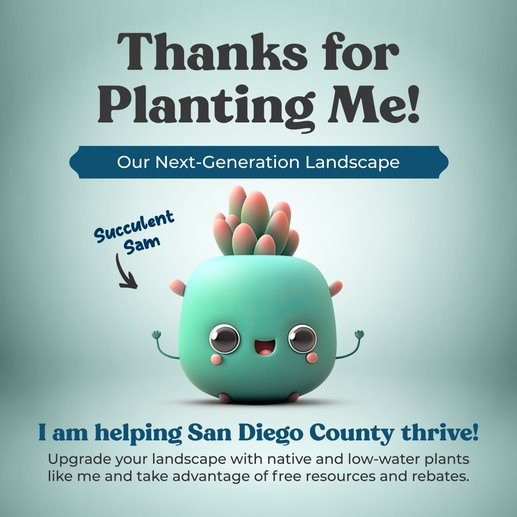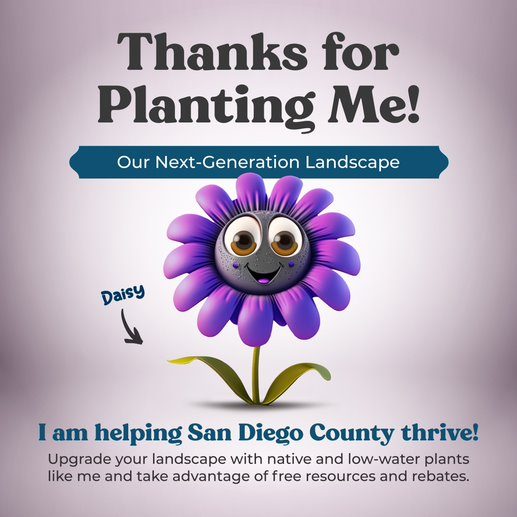“Thanks for Planting Me!” encourages more widespread adoption of sustainable landscapes to prepare the Southern California region for a hotter and drier climate.
The “Thanks for Planting Me!” summer campaign offers gratitude to the hundreds of thousands of San Diegans who have transformed their landscapes using low-water and native plants as part of a larger effort to use water more efficiently. Thanks for Planting Me! also is intended to show resident the WaterSmart advantages of embracing regenerative low-water landscapes as climate change stresses water supplies across the Southwest.
Sponsored by the San Diego County Water Authority, and supported by state grant funds to promote water-use efficiency, the “spokesplants” will appear on a variety of digital and outdoor advertising platforms starting in May, Water Awareness Month.

Thanks for Planting Me!
Promoting water conservation with landscape transformation complements similar efforts to promote on-going water-use efficiency by the Metropolitan Water District of Southern California and the State of California’s Save Our Water program. The “Thanks for Planting Me!” campaign is driven by a collection of animated plant personalities like Succulent Sam and Rose Marie who express their appreciation for being adopted across San Diego County as the “next-generation landscape.”
The Water Authority and its retail member agencies are also planning to participate in community events over the summer – including the San Diego County Fair – to promote landscapes that provide numerous environmental benefits, including storm-water retention and healthy soils. In addition, the Water Authority has renewed a long-running partnership with San Diego Zoo Wildlife Alliance to co-brand signage at the San Diego Zoo Safari Park’s conservation garden. The signs educate park visitors about water use practices on park grounds and how people can improve water use on their own landscapes.

Low-water landscapes for dry climate
“Three years of extreme drought are over, but they remind us about severe water management challenges across the Southwest,” said Water Authority General Manager Sandra L. Kerl. “San Diego County has embraced water-use efficiency like few places across the nation, however, there’s always a next step.
“We should not lose the urgency created by the drought to continue adoption of low-water landscapes. This summer outreach effort is a fun way to both thank residents and remind them about resources that the Water Authority and our partners offer as we prepare for the inevitable dry years ahead.”

Rebates, plant guides
Those resources include rebates for lawn replacement, rain barrels and other water-efficient devices; on-demand videos filled with landscaping tips; plant guides to make selection easier; and digital workbooks that provide guidance for creating beautiful, low-maintenance landscapes that use far less water than turfgrass. About half of the water used at typical homes is used outside, providing ample opportunities for long-term reductions in water-use.
“There are now thousands of residential and commercial landscapes in our region that show just how attractive and functional climate-friendly landscapes are; most people don’t need or use grass – they just need a little encouragement to find an alternative,” Kerl said. “Using the summer months to plan for landscape upgrades, means you can be ready to take action in the fall and winter when it’s time to plant.”
Long-term challenges for water supply sources
Decades of investments in water supplies, water infrastructure and efficiency measures have insulated San Diego County from recent droughts. The long-term challenges across the Southwest remain given the severe depletion of the Colorado River and groundwater basins.
“Fundamentally, we are no longer talking about drought but an entirely different reality than we were in decades past – the era of climate-driven impacts to our natural resources,” Kerl said. “Every person in San Diego and the western U.S. must continue to eliminate water waste, adopt low-water landscapes, capture rainwater, and take other steps to adapt to a hotter and drier future.”
The “Thanks for Planting Me!” campaign is supported with grant funds from by the Water Quality, Supply and Infrastructure Improvement Act of 2014, administered by the State of California, Department of Water Resources.
For more information, go to www.sdcwa.org/plant-me.






